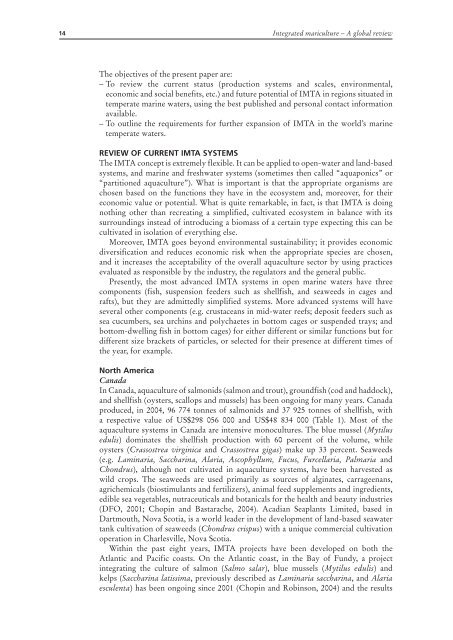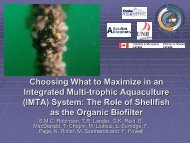Integrated multi-trophic aquaculture (IMTA) in marine temperate waters
Integrated multi-trophic aquaculture (IMTA) in marine temperate waters
Integrated multi-trophic aquaculture (IMTA) in marine temperate waters
Create successful ePaper yourself
Turn your PDF publications into a flip-book with our unique Google optimized e-Paper software.
14<br />
<strong>Integrated</strong> mariculture – A global review<br />
The objectives of the present paper are:<br />
– To review the current status (production systems and scales, environmental,<br />
economic and social benefits, etc.) and future potential of <strong>IMTA</strong> <strong>in</strong> regions situated <strong>in</strong><br />
<strong>temperate</strong> mar<strong>in</strong>e <strong>waters</strong>, us<strong>in</strong>g the best published and personal contact <strong>in</strong>formation<br />
available.<br />
– To outl<strong>in</strong>e the requirements for further expansion of <strong>IMTA</strong> <strong>in</strong> the world’s mar<strong>in</strong>e<br />
<strong>temperate</strong> <strong>waters</strong>.<br />
REVIEW OF CURRENT <strong>IMTA</strong> SYSTEMS<br />
The <strong>IMTA</strong> concept is extremely flexible. It can be applied to open-water and land-based<br />
systems, and mar<strong>in</strong>e and freshwater systems (sometimes then called “aquaponics” or<br />
“partitioned <strong>aquaculture</strong>”). What is important is that the appropriate organisms are<br />
chosen based on the functions they have <strong>in</strong> the ecosystem and, moreover, for their<br />
economic value or potential. What is quite remarkable, <strong>in</strong> fact, is that <strong>IMTA</strong> is do<strong>in</strong>g<br />
noth<strong>in</strong>g other than recreat<strong>in</strong>g a simplified, cultivated ecosystem <strong>in</strong> balance with its<br />
surround<strong>in</strong>gs <strong>in</strong>stead of <strong>in</strong>troduc<strong>in</strong>g a biomass of a certa<strong>in</strong> type expect<strong>in</strong>g this can be<br />
cultivated <strong>in</strong> isolation of everyth<strong>in</strong>g else.<br />
Moreover, <strong>IMTA</strong> goes beyond environmental susta<strong>in</strong>ability; it provides economic<br />
diversification and reduces economic risk when the appropriate species are chosen,<br />
and it <strong>in</strong>creases the acceptability of the overall <strong>aquaculture</strong> sector by us<strong>in</strong>g practices<br />
evaluated as responsible by the <strong>in</strong>dustry, the regulators and the general public.<br />
Presently, the most advanced <strong>IMTA</strong> systems <strong>in</strong> open mar<strong>in</strong>e <strong>waters</strong> have three<br />
components (fish, suspension feeders such as shellfish, and seaweeds <strong>in</strong> cages and<br />
rafts), but they are admittedly simplified systems. More advanced systems will have<br />
several other components (e.g. crustaceans <strong>in</strong> mid-water reefs; deposit feeders such as<br />
sea cucumbers, sea urch<strong>in</strong>s and polychaetes <strong>in</strong> bottom cages or suspended trays; and<br />
bottom-dwell<strong>in</strong>g fish <strong>in</strong> bottom cages) for either different or similar functions but for<br />
different size brackets of particles, or selected for their presence at different times of<br />
the year, for example.<br />
North America<br />
Canada<br />
In Canada, <strong>aquaculture</strong> of salmonids (salmon and trout), groundfish (cod and haddock),<br />
and shellfish (oysters, scallops and mussels) has been ongo<strong>in</strong>g for many years. Canada<br />
produced, <strong>in</strong> 2004, 96 774 tonnes of salmonids and 37 925 tonnes of shellfish, with<br />
a respective value of US$298 056 000 and US$48 834 000 (Table 1). Most of the<br />
<strong>aquaculture</strong> systems <strong>in</strong> Canada are <strong>in</strong>tensive monocultures. The blue mussel (Mytilus<br />
edulis) dom<strong>in</strong>ates the shellfish production with 60 percent of the volume, while<br />
oysters (Crassostrea virg<strong>in</strong>ica and Crassostrea gigas) make up 33 percent. Seaweeds<br />
(e.g. Lam<strong>in</strong>aria, Sacchar<strong>in</strong>a, Alaria, Ascophyllum, Fucus, Furcellaria, Palmaria and<br />
Chondrus), although not cultivated <strong>in</strong> <strong>aquaculture</strong> systems, have been harvested as<br />
wild crops. The seaweeds are used primarily as sources of alg<strong>in</strong>ates, carrageenans,<br />
agrichemicals (biostimulants and fertilizers), animal feed supplements and <strong>in</strong>gredients,<br />
edible sea vegetables, nutraceuticals and botanicals for the health and beauty <strong>in</strong>dustries<br />
(DFO, 2001; Chop<strong>in</strong> and Bastarache, 2004). Acadian Seaplants Limited, based <strong>in</strong><br />
Dartmouth, Nova Scotia, is a world leader <strong>in</strong> the development of land-based seawater<br />
tank cultivation of seaweeds (Chondrus crispus) with a unique commercial cultivation<br />
operation <strong>in</strong> Charlesville, Nova Scotia.<br />
With<strong>in</strong> the past eight years, <strong>IMTA</strong> projects have been developed on both the<br />
Atlantic and Pacific coasts. On the Atlantic coast, <strong>in</strong> the Bay of Fundy, a project<br />
<strong>in</strong>tegrat<strong>in</strong>g the culture of salmon (Salmo salar), blue mussels (Mytilus edulis) and<br />
kelps (Sacchar<strong>in</strong>a latissima, previously described as Lam<strong>in</strong>aria sacchar<strong>in</strong>a, and Alaria<br />
esculenta) has been ongo<strong>in</strong>g s<strong>in</strong>ce 2001 (Chop<strong>in</strong> and Rob<strong>in</strong>son, 2004) and the results



